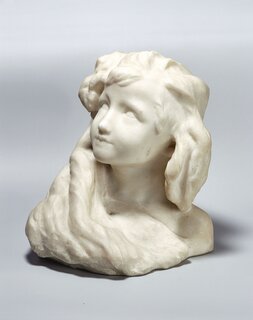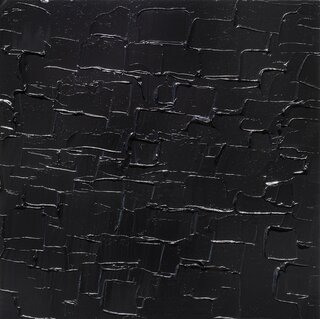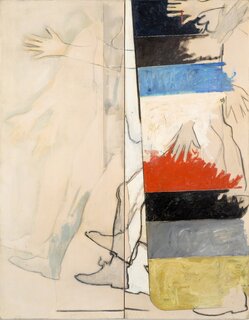
"A definitive painting from Franz Kline’s mature period, Third Avenue (1954) was exhibited, two years after its completion, in the 1956 Venice Biennale. This canvas features the artist’s signature palette of black and white, accenting its dramatic contrast with passages of off-white and colors that emerge subtly from its underpainting. Visually articulating the vertical format of his support, Kline defined a series of nested, near-rectangular shapes into a bold composition that balances imposing structure with compelling variations in forms and contours. The taut dynamism of Third Avenue is reinforced by Kline’s varied application of paint, as seen in his energetic brushstrokes, irregular edges, and drips in the work’s bottom register.
In composing his work, Kline lent equal weight to additive and subtractive gestures, building the painting up through a twinned process of what he described as “painting it out or putting it in.” The result is a dynamic structure that offers the viewer areas of tension and relaxation, a confluence of opposing forms and forces that Kline called “organizing” and “disorganizing.” As he explained, he aimed to capture “a certain sense of the awkwardness of ‘not-balance,’ the tentative reality of lack of balance in it.” The result is a dynamic pictorial space, wherein his charged gestures, rather than existing as stable figures atop a fixed ground, coexist in a dense interweave.
Born in 1910 in Wilkes-Barre, Pennsylvania, Kline studied painting and drawing in Boston and London before settling in New York in 1938. Frequenting the famous Cedar Tavern in Greenwich Village, he befriended the members of the nascent New York School, including Jackson Pollock and Willem de Kooning. In 1949, at the prompting of de Kooning, he began to enlarge certain of his black-and-white ink drawings, made on torn pages from telephone books, with a projector. The graphic power of his strokes isolated upon the wall led to his iconic black-and-white paintings, which he first exhibited in New York in 1950. Third Avenue dates from this vital era of development.
To create these works, Kline used thick housepainters’ brushes to lay down oil paint in sweeping gestures. The resulting forms radiate energy and intensity, inviting comparison to imposing urban architecture such as bridges, skyscrapers, and scaffolding. At the time he completed Third Avenue, Kline worked in a studio at 32 East 10th Street, a few blocks away from 3rd Avenue. At the time, an elevated railway ran along the avenue; abandoned and dismantled in 1955, the year after Kline completed this painting, the 3rd Avenue El was the last of its kind in Manhattan. Conveying the imposing form of girders as well as the energy of the trains they supported without directly representing them, the present painting embodies Kline’s fascination with structure, speed, and gesture.
Third Avenue was shown in the American Pavilion of the Venice Biennale in 1956, alongside Abstract Expressionist paintings by Pollock, de Kooning, and Mark Tobey. The presentation was organized by Katherine Kuh, curator at the Art Institute of Chicago, with Kline’s work epitomizing her theme of “American Artists Paint the City.” “If American artists paint their cities abstractly,” Kuh wrote in the exhibition catalogue, “they may be recording quite realistically what they see, for the angularity, speed and transparency of their surroundings often appear abstract when viewed out of context.” The features of Kline’s painting, Kuh noted, “symbolize a whole metropolis,” conveying an energy that captures the “staccato excitement” of the contemporary American city."




